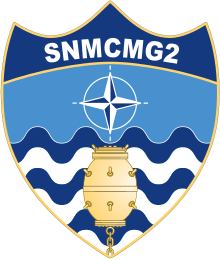
The Sixth Fleet is a numbered fleet of the United States Navy operating as part of United States Naval Forces Europe and Africa. The Sixth Fleet is headquartered at Naval Support Activity Naples, Italy. The officially stated mission of the Sixth Fleet in 2011 is that it "conducts the full range of Maritime Operations and Theater Security Cooperation missions, in concert with coalition, joint, interagency, and other parties, in order to advance security and stability in Europe and Africa." The current commander of the Sixth Fleet is Vice Admiral Jeffrey T. Anderson.

The Supreme Headquarters Allied Powers Europe (SHAPE) is the military headquarters of the North Atlantic Treaty Organization's (NATO) Allied Command Operations (ACO) that commands all NATO operations worldwide. SHAPE is situated in the village of Casteau, near Mons, Belgium.

The Seventh Fleet is a numbered fleet of the United States Navy. It is headquartered at U.S. Fleet Activities Yokosuka, in Yokosuka, Kanagawa Prefecture, Japan. It is part of the United States Pacific Fleet. At present, it is the largest of the forward-deployed U.S. fleets, with 50 to 70 ships, 150 aircraft and 27,000 sailors and marines. Its principal responsibilities are to provide joint command in natural disaster or military operations and operational command of all U.S. naval forces in the region.

Standing Royal Navy deployments is a list of operations and commitments undertaken by the United Kingdom's Royal Navy on a worldwide basis. The following list details these commitments and deployments sorted by region and in alphabetical order. Routine deployments made by the Navy's nuclear-powered submarines and their location of operations is classified.

Standing NATO Maritime Group One (SNMG1) is one of NATO's standing naval maritime immediate reaction forces. SNMG1 consists of four to six destroyers and frigates. Its role is to provide NATO with an immediate operational response capability.

Standing NATO Mine Countermeasures Group 1 (SNMCMG1) is a North Atlantic Treaty Organisation (NATO) standing mine countermeasures immediate reaction force. Its role is to provide NATO with an immediate operational response capability.

Standing NATO Maritime Group 2 (SNMG2) is a North Atlantic Treaty Organization (NATO) standing maritime immediate reaction force. SNMG2 consists of four to six destroyers and frigates. Its role is to provide NATO with an immediate operational response capability.

The Supreme Allied Commander Atlantic (SACLANT) was one of two supreme commanders of the North Atlantic Treaty Organisation (NATO), the other being the Supreme Allied Commander Europe (SACEUR). The SACLANT led Allied Command Atlantic was based at Norfolk, Virginia. The entire command was routinely referred to as 'SACLANT'.

The Estonian Navy are the unified naval forces among the Estonian Defence Forces.

Operation Active Endeavour was a maritime operation of the North Atlantic Treaty Organization. It operated in the Mediterranean Sea and was designed to prevent the movement of terrorists or weapons of mass destruction. It had collateral benefits in enhanced security of shipping in general. It was one of the first military actions taken by NATO in response to an invocation of Article 5 of the North Atlantic Treaty which provides for collective defense and the first-ever operation conducted by the Alliance in direct application of the defense clause of the Treaty. In November 2016 it was replaced by the non-Article-5 Operation Sea Guardian.

HMS Grimsby was a Sandown-class minehunter of the British Royal Navy, serving from 1999–2022, and the second ship to bear the name.

HMS Cattistock, the third ship of this name, is a Hunt-class mine countermeasures vessel of the Royal Navy. She was launched in 1981 and commissioned on 5 March 1982, the third ship of her class.

USS Adroit (AM-509/MSO-509) was an minesweeper acquired by the U.S. Navy for the task of removing mines that had been placed in the water to prevent the safe passage of ships.
The structure of the North Atlantic Treaty Organization (NATO) is complex and multi-faceted. The decision-making body is the North Atlantic Council (NAC), and the member state representatives also sit on the Defence Policy and Planning Committee (DPPC) and the Nuclear Planning Group (NPG). Below that the Secretary General of NATO directs the civilian International Staff, that is divided into administrative divisions, offices and other organizations. Also responsible to the NAC, DPPC, and NPG are a host of committees that supervise the various NATO logistics and standardisation agencies.

Allied Maritime Command (MC) Naples was a subordinate command of Allied Joint Force Command Naples. MC Naples operated from the island of Nisida in the Gulf of Pozzuoli and its commander reported directly to the Commander Allied Joint Force Command Naples. The command was deactivated in March 2013.

The Allied Maritime Command (MARCOM) is the central command of all NATO maritime forces and the Commander MARCOM is the prime maritime advisor to the Alliance. When directed by the Supreme Allied Commander Europe (SACEUR), it provides the core of the headquarters responsible for the conduct of maritime operations. The command is based at the Northwood Headquarters in Eastbury, Hertfordshire.

Naval Striking and Support Forces NATO (STRIKFORNATO) is a naval command of Allied Command Operations of North Atlantic Treaty Organization (NATO). It is part of the NATO Force Structure. STRIKFORNATO is commanded by the Commander of the United States Sixth Fleet, and it is the only command capable of leading an expanded maritime task force. Its predecessor was Naval Striking and Support Forces Southern Europe (STRIKFORSOUTH); the name change took place in 2004.

Allied Command Channel (ACCHAN) was one of three major North Atlantic Treaty Organization (NATO) commands from 1952 to 1994. Commander-in-Chief Channel was a Major NATO Commander (MNC).

Elbe (A511) is the lead ship of the Elbe-class replenishment ships of the German Navy.

Denmark participates in NATO as a maritime security ally. It has a maritime heritage and a position bridging Europe and the Arctic.



















